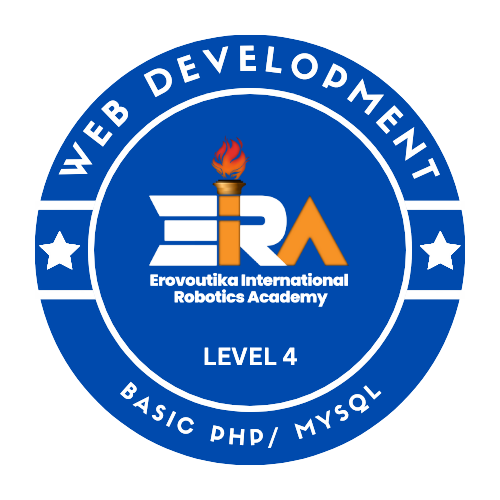Enrollment Web Development
Certifications Level 4
Certifications
Basic PHP/ MySQL
 LEVEL 4
Basic PHP/ MySQL
LEVEL 4
Basic PHP/ MySQL
PHP (Hypertext Preprocessor):
PHP is a server-side scripting language that is embedded in HTML, allowing developers to create dynamic content on web pages. It is open-source and has a large and active community, making it widely supported and continuously evolving. PHP can interact with databases, handle form data, manage cookies and sessions, and perform various server-side tasks. With its simple syntax and ease of integration with HTML, PHP enables developers to build complex web applications efficiently. PHP is commonly used in conjunction with MySQL to perform database operations, making it a preferred choice for back-end development.
PHP is a server-side scripting language that is embedded in HTML, allowing developers to create dynamic content on web pages. It is open-source and has a large and active community, making it widely supported and continuously evolving. PHP can interact with databases, handle form data, manage cookies and sessions, and perform various server-side tasks. With its simple syntax and ease of integration with HTML, PHP enables developers to build complex web applications efficiently. PHP is commonly used in conjunction with MySQL to perform database operations, making it a preferred choice for back-end development.
MySQL:
MySQL is an open-source relational database management system (RDBMS) known for its speed, scalability, and reliability. It is widely used in web development to store and manage structured data efficiently. MySQL follows the SQL (Structured Query Language) standard, making it easy to interact with databases using queries. With its support for various data types and powerful features like indexing and caching, MySQL offers optimized database performance. It integrates seamlessly with PHP, allowing developers to retrieve, insert, update, and delete data from databases in web applications. MySQL is a popular choice for web projects of all sizes, from small websites to large-scale applications, due to its robustness and stability.
MySQL is an open-source relational database management system (RDBMS) known for its speed, scalability, and reliability. It is widely used in web development to store and manage structured data efficiently. MySQL follows the SQL (Structured Query Language) standard, making it easy to interact with databases using queries. With its support for various data types and powerful features like indexing and caching, MySQL offers optimized database performance. It integrates seamlessly with PHP, allowing developers to retrieve, insert, update, and delete data from databases in web applications. MySQL is a popular choice for web projects of all sizes, from small websites to large-scale applications, due to its robustness and stability.
Exam Coverage
1. PHP Basics
* Introduction to PHP and its role in server-side web development * PHP syntax and data types
* Working with variables, arrays, and conditional statements (if-else, switch)
* Loops (for, while, foreach) and control structures in PHP
* Understanding PHP functions and their usage
* PHP form handling and processing user input
* Managing PHP sessions and cookies
2. MySQL Database
* Introduction to MySQL and its role in database management * Creating and managing MySQL databases and tables
* Basic CRUD operations (Create, Read, Update, Delete) in MySQL
* SQL queries for data retrieval (SELECT), data insertion (INSERT), data update (UPDATE), and data deletion (DELETE)
* Working with MySQL data types and database normalization
* Understanding MySQL joins and how to retrieve data from multiple tables
3. PHP and MySQL Integration
* Connecting PHP to MySQL database * Executing SQL queries from PHP
* Fetching data from MySQL and displaying it using PHP
* Inserting, updating, and deleting data in MySQL using PHP
* Using PHP to validate and process form data and store it in the database
* Managing user authentication and sessions with PHP and MySQL
4. Advanced Concepts
* Introduction to prepared statements for secure database operations * Understanding PHP error handling and debugging techniques
* File handling in PHP: reading, writing, and uploading files
* Exploring PHP frameworks (e.g., Laravel, CodeIgniter) for efficient development
* Implementing basic security measures to prevent common web vulnerabilities
How to evaluate examination ?
1. PHP Fundamentals
The exam assesses students' ability to demonstrate correct implementation of PHP syntax, data types, variables,
arrays, and conditional statements, as well as accurate usage of loops (for, while, foreach) and control structures
(if-else, switch) in PHP. Additionally, it evaluates their understanding and utilization of PHP functions for code
organization and reusability, proper handling of PHP forms, and effective management of PHP sessions and cookies for
user authentication and data persistence.
2. MySQL Database Operations
The exam evaluates students' ability to demonstrate accurate creation and management of MySQL databases and tables,
correct implementation of basic CRUD operations (Create, Read, Update, Delete) in MySQL, and accurate usage of SQL
queries (SELECT, INSERT, UPDATE, DELETE) for data retrieval and manipulation. Additionally, it assesses their
understanding and application of MySQL data types and database normalization, as well as their proficiency in using
MySQL joins to retrieve data from multiple tables.
3. PHP and MySQL Integration
Successful connection establishment between PHP and MySQL database.
Correct execution of SQL queries from PHP and handling of query results.
Accurate fetching and displaying of data retrieved from MySQL using PHP.
Proper insertion, updating, and deletion of data in MySQL using PHP.
Secure handling of form data validation and processing using PHP and MySQL.
| Exam Name | Exam WDV-104 |
|---|---|
| Pre-requisites | WDV-102 / WDV-103 |
| Validity | Lifetime |
| Exam Duration | 55 minutes |
| Number of Questions | 40 questions |
| Type of Question | Multiple Choice |
| Passing Score | 70% |
| Cost | $17 USD |
| Languages | English |